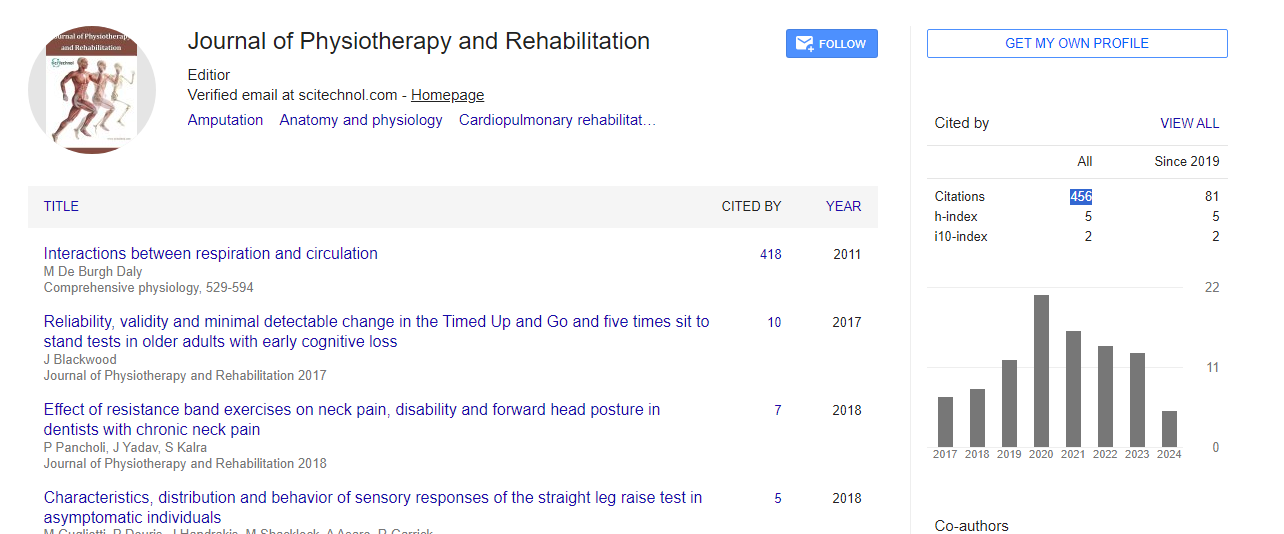Opinion Article, J Physiother Rehabi Vol: 8 Issue: 1
Innovations in Rheumatological Rehabilitation: Advancing Treatment Approaches
Bitar Hsu Li*
1Louisiana State University Medical Center, New Orleans, LA 70112, USA
*Corresponding Author: Bitar Hsu Li,
Louisiana State University Medical Center,
New Orleans, LA 70112, USA
E-mail: lihsu@b.edu
Received date: 02 January, 2024, Manuscript No. JPTR-24-134578;
Editor assigned date: 04 January, 2024, PreQC No. JPTR-24-134578 (PQ);
Reviewed date: 18 January, 2024, QC No. JPTR-24-134578;
Revised date: 26 January, 2024, Manuscript No. JPTR-24-134578 (R);
Published date: 02 February, 2024, DOI: 10.4172/JPTR.1000158.
Citation: Li BH (2024) Innovations in Rheumatological Rehabilitation: Advancing Treatment Approaches. J Physiother Rehabi 8:1.
Description
Rheumatological conditions, encompassing a wide array of disorders such as arthritis, lupus, and fibromyalgia, pose significant challenges to individuals quality of life. These conditions often lead to pain, stiffness, reduced mobility, and fatigue, affecting daily activities and overall well-being. In recent years, there has been a remarkable surge in innovations within the field of rheumatological rehabilitation, aimed at enhancing treatment approaches and improving outcomes for patients. This essay explores some of the key innovations in rheumatological rehabilitation and their impact on advancing patient care.
One of the notable advancements in rheumatological rehabilitation is the emphasis on personalized treatment plans tailored to the individual needs of patients. Recognizing that each patient's experience with rheumatological conditions is unique, healthcare providers are increasingly adopting a patient-centered approach to rehabilitation. This approach takes into account factors such as disease severity, functional limitations, comorbidities, and patient preferences to design comprehensive and tailored rehabilitation programs. By addressing the specific needs and goals of each patient, personalized treatment plans have shown promising results in improving outcomes and enhancing patient satisfaction.
Another significant innovation in rheumatological rehabilitation is the integration of technology into treatment approaches. Digital health tools, such as mobile applications, wearable devices, and telerehabilitation platforms, have revolutionized the delivery of rehabilitation services, particularly in remote or underserved areas. These technologies enable patients to access rehabilitation resources, track their progress, and communicate with healthcare providers conveniently from their homes. Additionally, virtual reality-based rehabilitation programs have emerged as a novel approach to enhancing engagement and motivation in rehabilitation exercises, thereby improving adherence and outcomes for patients with rheumatological conditions.
Furthermore, there has been growing recognition of the importance of interdisciplinary collaboration in rheumatological rehabilitation. Multidisciplinary teams consisting of rheumatologists, physiotherapists, occupational therapists, nurses, and other healthcare professionals work collaboratively to address the complex needs of patients with rheumatological conditions. This collaborative approach allows for comprehensive assessment, individualized intervention, and coordinated care management, leading to more comprehensive and effective rehabilitation outcomes. Moreover, interdisciplinary collaboration facilitates the exchange of knowledge and expertise among healthcare professionals, fostering continuous learning and innovation in the field of rheumatological rehabilitation.
Innovative therapeutic modalities have also emerged as a key area of advancement in rheumatological rehabilitation. In addition to traditional approaches such as exercise therapy and manual therapy, novel interventions such as hydrotherapy, and yoga have gained recognition for their potential benefits in managing symptoms and improving function in patients with rheumatological conditions. These alternative modalities offer gentler and more accessible options for patients who may have difficulty engaging in conventional rehabilitation exercises due to pain or stiffness. Moreover, emerging evidence suggests that mind-body interventions, such as mindfulnessbased stress reduction and cognitive-behavioral therapy, can complement physical rehabilitation efforts by addressing psychological factors that impact pain perception and coping strategies.
Conclusion
Innovations in rheumatological rehabilitation are transforming treatment approaches and enhancing outcomes for patients with rheumatological conditions. From personalized treatment plans and technology integration to interdisciplinary collaboration and innovative therapeutic modalities, these advancements are reshaping the landscape of rheumatological care. By embracing innovation and adopting a comprehensive and patient-centered approach to rehabilitation, healthcare providers can continue to improve the lives of individuals living with rheumatological conditions, empowering them to achieve optimal health and well-being.
 Spanish
Spanish  Chinese
Chinese  Russian
Russian  German
German  French
French  Japanese
Japanese  Portuguese
Portuguese  Hindi
Hindi 